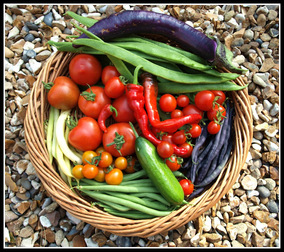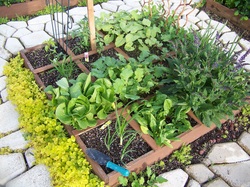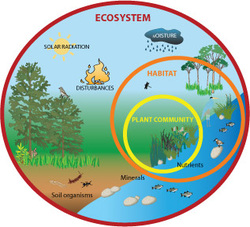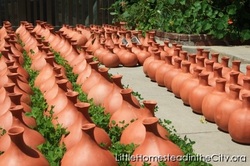
so get out your journal and a pen, write down your ideas and experiences and as always happy gardening.
the denver public library
| g squared environmental design |
|
 as fall quickly approaches and you are getting ready to put your garden away for the season, remember some simple rules for next year. one thing that helps me remember what to do for next year is keeping a journal with sketches. what worked, what didn't, what needs more water, what needs more sun...writing down and sketching things is tremendously helpful for next years harvest to be bigger and better. another important thing that will be beneficial is removal of all dead, dying or disease plant material. you want to start the spring with a clean slate so to speak. you can also cover your soil with cloth, straw or another ground cover depending on what you want to use the soil for the following year. this would also be a good time to add to your compost bin or start one from scratch. i am not going to go into composting in this post however look for one in a future post. as with anything in life simplifying, organizing and planning will go a long way for you and make your life easier in the spring. there are tons of web resources, books and blogs for you to peruse. if you are a novice or even an expert, let me suggest on of the finest resources you can have that won't cost you a penny (unless your late), a library card. so get out your journal and a pen, write down your ideas and experiences and as always happy gardening. the denver public library
0 Comments
 garden smarter not harder… a lot of people are transitioning from growing lawns to growing food. depending on where you live this can be a very tricky subject. some municipalities require you to acquire a variance or special permit to grow things higher than 12 inches (in your front yard). here in denver height isn’t so much the issue as is the use of water. if you choose to go this route, my suggestion is, plan your garden and the watering zones with sensitivity and caution. plan(t) smarter don’t work harder. one method that is simple to design for the diy folks out there is the square foot gardening method. square foot gardening combines several methods; bio-intensive planting, composting, organic gardening and is often planted in raised beds. there are many books and websites on this subject and it can be as plain as a square bed or as intricate as you can dream up. when you start to design your space plant things close together that have similar watering requirements to help eliminate over or under usage of water. planting and watering in zones is a good method to follow, especially in the desert or other places experiencing droughts. get creative when watering; use olla’s, drip systems and rain barrels if you location allows it. the more efficient your garden is started, the more time you will have to enjoy it. using simple methods such as these will help streamline your gardening time and use your resources more efficiently. if you have any questions on square foot gardening or setting up watering zones send me a message. resources on square foot gardening and watering methods: http://www.squarefootgardening.org/ http://www.denverwater.org/Conservation/TipsTools/Outdoor/WateringYourLawn/ http://www.rainbird.com/homeowner/education/watersavingtips.htm happy gardening…  growing native… when most people ask me questions about landscaping it’s because they need advice on what to do with their space. i tell them it is very similar to real estate; location is everything. not only the location of where you live, it is also the location of where you want to put elements. you can, in theory, grow almost anything almost anywhere. this method however requires a lot of resources, like water and great soil to name a couple. this does not guarantee that your garden will thrive. and you don’t want your landscaping to merely exist… you want it to thrive! the right plant for the right place is the mantra we are taught in landscape architecture. so it stands to reason that different climates call for different requirements as far as resources and plant palate selection. one common method to minimize the use of resources, such as water, is to choose a plant palate that is considered native and non-invasive. a native plant, tree or shrub can best be described as one that is indigenous or naturalized to an area and usually refers to species that were there before colonization. invasive species can wreak havoc on something as small as a yard to something as large as an ecological system. so when designing a space, environmental sensitivity should be considered if you wish to conserve resources and want your landscape to thrive. resources on native and non-invasive species in colorado: http://www.slideshare.net/Fujita64g/a1o351 http://jeffco.us/coopext/intro.jsp http://www.ext.colostate.edu/ptlk/1710.html happy gardening…  use only what you need, it’s a drought! this slogan is, in my opinion, all wrong. the slogan should be… IT’S A DESERT! so in the interest of debating how much water denver should and shouldn’t be using, let’s explore some options to utilize it more efficiently in this desert landscape. in today’s post we will talk about an OLLA (pronounced oh-yah). traditionally olla’s are made of porous non finished clay pottery and are used for many things, including irrigation. they typically have a bulbous bottom with a narrow neck. they can be made and/or bought in many different sizes and shapes can vary as well. you bury the pot with the neck opening above the soil line so that it can be filled with water. the water will then slowly seep through the pot into the soil and be readily available for you plants to drink. using an olla illuminates runoff, slows down evaporation and supplies the water directly to the roots of your plant(s). resources and photos: http://drippingspringsollas.com/ http://growingawarenessurbanfarm.com/ollas http://rosedalegarden.org/olla-irrigation/ http://youtu.be/qkNxACJ9vPI here is a link that gives a good explanation of an olla and how to use them: http://youtu.be/fvKq5geEM-A some people have come up with creative ways to re-purpose other items into ollas. you can use a milk jug as seen at the link: http://youtu.be/pCkeB2l3ODQ others have used two terra cotta pots and adhere them together as shown in this link: http://youtu.be/s0BryMMFwME these are just a few resources and videos about ollas and are by no means an exhaustive list. it is a good starting point for those interested in ollas and water conservation, especially in the southwest and more arid climates. happy gardening... |
g2designer, artist, photographer, traveler extraordinaire, consultant, teacher and student... archives
September 2014
categories
All
|